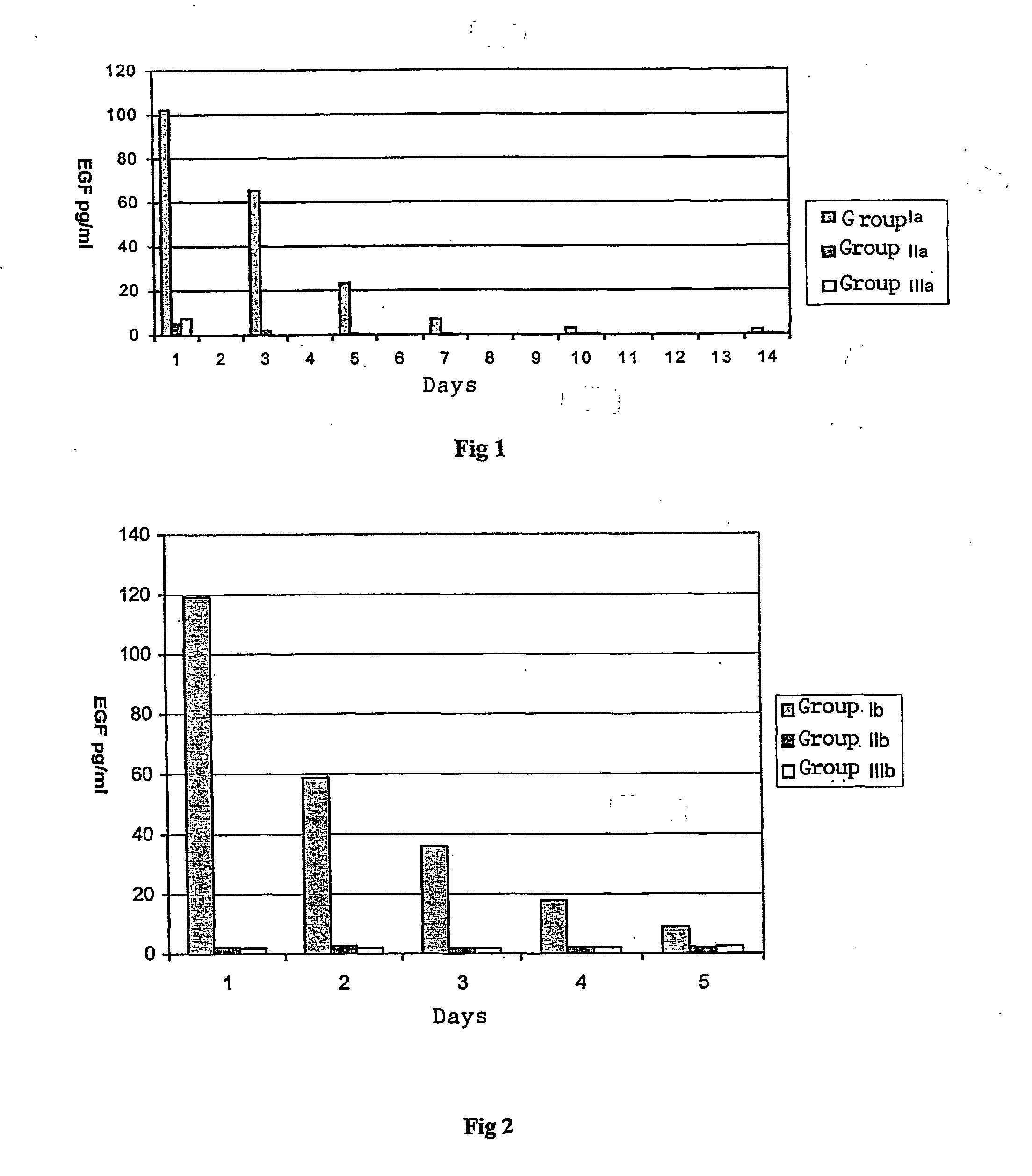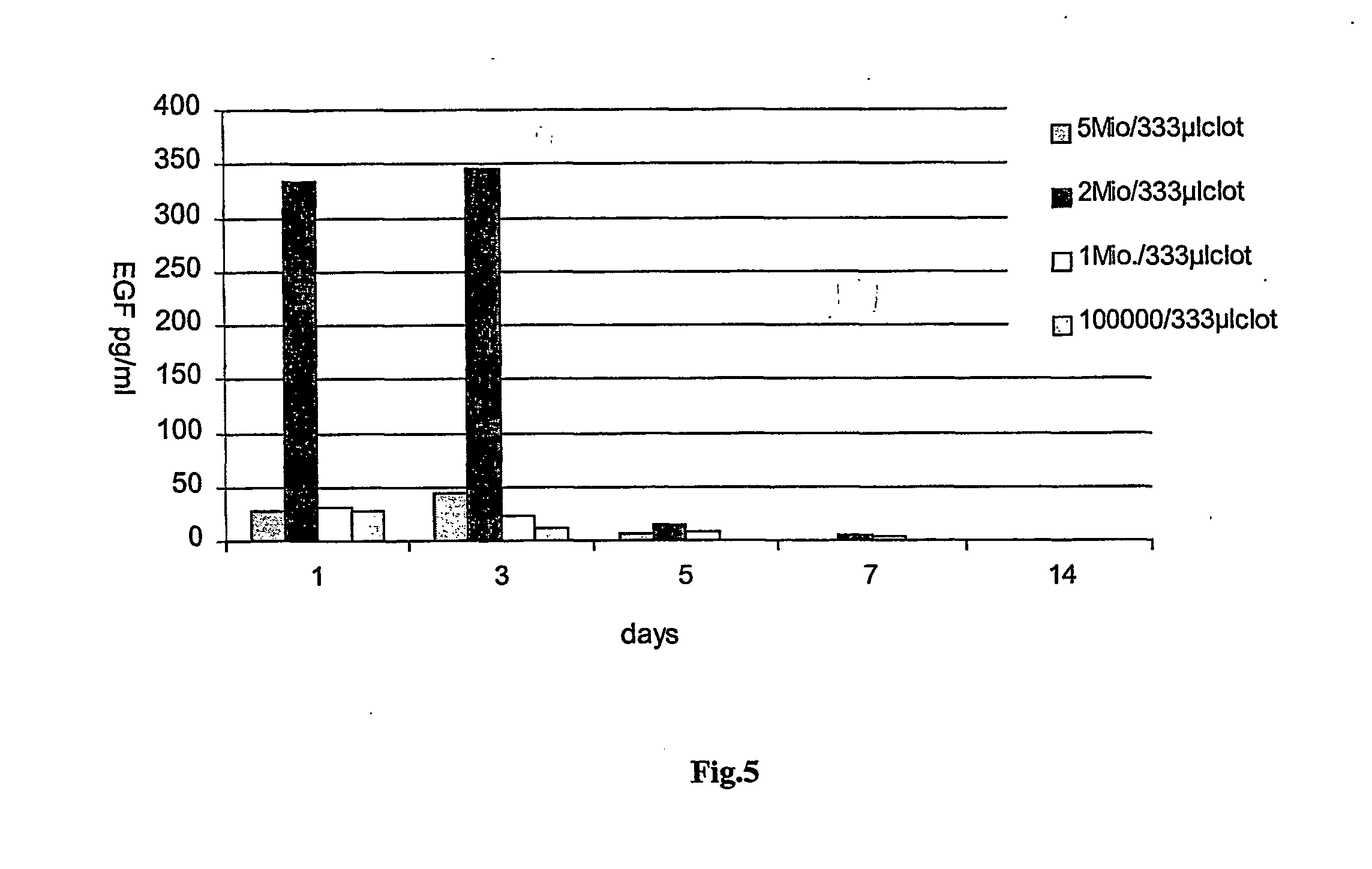Transfection system
- Summary
- Abstract
- Description
- Claims
- Application Information
AI Technical Summary
Benefits of technology
Problems solved by technology
Method used
Image
Examples
example 2
[0110] Determination of the optimal keratinocyte concentration for a given buffer. EGF-plasmid, Tissucol.RTM. and cell preparations were used as described in Example 1. Only the amount of keratinocytes was varied between 100,000, 1 million, 2 millions and 5 millions. The highest expression rates of EGF were obtained in using a cell number of 2 millions / 333 .mu.l of fibrin clot, which amounts to about 6 millions cells / ml of clot (see FIG. 5).
example 3
[0111] Optimization of a gene activated matrix for the treatment of full thickness wounds of nude mice.
[0112] Full thickness wounds of nude mice (12 mice per group) were treated with different combinations (groups 1-4). The amount of fibrin in each case was 333 .mu.l, the amount of plasmid 200 .mu.g. In each case a pre-incubation of appropriate cells with the plasmid was carried out in 5.7 .mu.l PBS for 3 hours. The amount of keratinocytes used was 2 millions. Biopsies were taken on days 1, 3, 5, 7, 9 and 12 and histologies starting with day 5.
1 Group 1: Fibrin and EGF-plasmid Group 2: Fibrin and keratinocytes Group 3: Fibrin, EGF-plasmid and endothelial cells (=support cells) Group 4: Fibrin, EGF-plasmid and keratinocytes (=repair cells)
[0113] The results of histologies clearly show that only group 4 leads to a full re-epithelialization of a full thickness wounds in nude mice, having a completely regenerated epithelium consisting of 9-11 layers of cells (see FIGS. 9 and 10).
[0114] ...
example 4
[0115] Transfection of Various Cell Types 200,000 cells, namely muscle cells, Schwann cells, endothelial cells, preadipocytes and fibroblasts, where transfected with 10 .mu.g of EGF-plasmid each, the amount of fibrin used was 333 .mu.l. Expression of EGF was measured after day 1, 2, 3, 4 and 5 and is shown in FIG. 11.
[0116] Examples for Isolation of Cells
[0117] Schwann Cells
[0118] Cells were prepared with modification according to the method of Shahar et al., (1989) in which Schwann cells were harvested from the sciatic nerve of neonatal rats. In brief, the Schwann cells were harvested from 7 mm segments of the sciatic nerve. Nerves were collected in HBSS, stripped of their epineurium and chopped into 1 mm.sup.2 pieces. The nerve pieces were dissociated by incubating the chunks for 30 minutes at 37.degree. C. with 0.3% trypsin and 0.1% collagenase. The cells were then triturated, washed and cultured with DMDM containing 10% FCS and penicillin / streptomycin on poly-D-lysine coated fla...
PUM
| Property | Measurement | Unit |
|---|---|---|
| Composition | aaaaa | aaaaa |
| Ratio | aaaaa | aaaaa |
Abstract
Description
Claims
Application Information
 Login to View More
Login to View More - R&D
- Intellectual Property
- Life Sciences
- Materials
- Tech Scout
- Unparalleled Data Quality
- Higher Quality Content
- 60% Fewer Hallucinations
Browse by: Latest US Patents, China's latest patents, Technical Efficacy Thesaurus, Application Domain, Technology Topic, Popular Technical Reports.
© 2025 PatSnap. All rights reserved.Legal|Privacy policy|Modern Slavery Act Transparency Statement|Sitemap|About US| Contact US: help@patsnap.com



